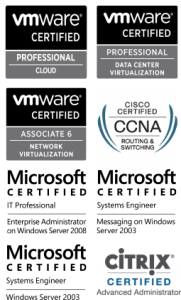Scenario
You’ve installed Active Directory Certificate Services and need to issue a certificate to Exchange 2010.
Tips, thoughts and notes from the world of IT
You’ve installed Active Directory Certificate Services and need to issue a certificate to Exchange 2010.
My good friend Steve and I were up till 02:30 Fri night / Sat morning doing further testing with Citrix XenApp 6.5 and the Citrix Receiver app on the iPad.
There were a few teething errors, but we got everything working fine in the end; including configuring an ActiveSync Profile for the iPad that installs a Root Certificate and pre-configures the Mail app to work with Exchange.
We used Hyper-V to setup a base VM of Server 2008 R2, then installed the following VMs using differencing disks which are similar to linked clones using VMware:
After a few short hours sleep, I decided to do exactly the same in my home lab too. Usually I use my ESXi server, but I thought this would be a great time to test out the latest version of VMware Workstation.
I didn’t take screenshots as usual, but here’s the notes I made:
I almost got caught out again earlier on the 32-bit ODBC admin console gotcha for 64-bit computers.
Luckily that first post I wrote at the start of the year helped me out. It really is great that this blog is becoming a great reference for me already. I don’t know if I should be proud of that, or ashamed that I forgot about the issue in under a year 😐
Anyway, in addition to using the correct ODBC admin console (C:\Windows\SysWOW64\odbcad32.exe), make sure you tick Return matched rows instead of affected rows and Enable dynamic cursors to make DocuWare run correctly:
You want to configure and control certificates throughout your IT Infrastructure.
Server 2008 R2 has this functionality built-in, so you just need to add the Server Role.
You’ve installed Windows Server 2008 R2 and are running it in “trial mode”.
You have a spare full license key, and you want to use this to convert the server from trial mode to the full version.
You’ve successfully installed and configured System Center Essentials (SCE) 2010. You now need to configure notifications.
There are 3 parts to this:
One of new features in Veeam Backup & Replication 6.1 is “File-level restore mount”:
When performed by the user interactively (using the backup console UI),
the Windows file-level restore process now mounts the volumes of the backed-up VM under C:\VeeamFLR.
This functionality is useful if you prefer to perform file-level recovery with native tools instead of Veeam
Backup Browser.
See this in action below.
I’ve just finished watching the best instructional video to date on Malware Hunting with the Sysinternals Tools, part of the latest TechEd 2012 sessions. There is also a similar PDF available for many of these tips.
The Sysinternals Suite has been my one of my favourite toolkits for many years, and although I already use most of the techniques shown in the video above, there were a few new features for me to get stuck into. Highly recommended.
Other TechEd sessions I’ve enjoyed watching include videos from the following speakers:
One of your HP 625 laptops will not boot up. There are no POST beeps and the screen is blank. The Caps Lock LED flashes continuously.
Go through the recommended steps from HP: http://h10010.www1.hp.com/ewfrf/wc/document?lc=en&dlc=en&cc=us&docname=c01732674&product=1132551#N213
This didn’t work for me, so I’ll be sending the laptop back under warranty. You can check warranty status here: https://h20565.www2.hp.com/portal/site/hpsc/public/wc/home/
You’ve just installed Exchange 2010 and now you want to migrate from Exchange 2007 to Exchange 2010.
Here’s the steps I took.

Copyright © 2019 · Enterprise Child Theme on Genesis Framework · WordPress · Log in